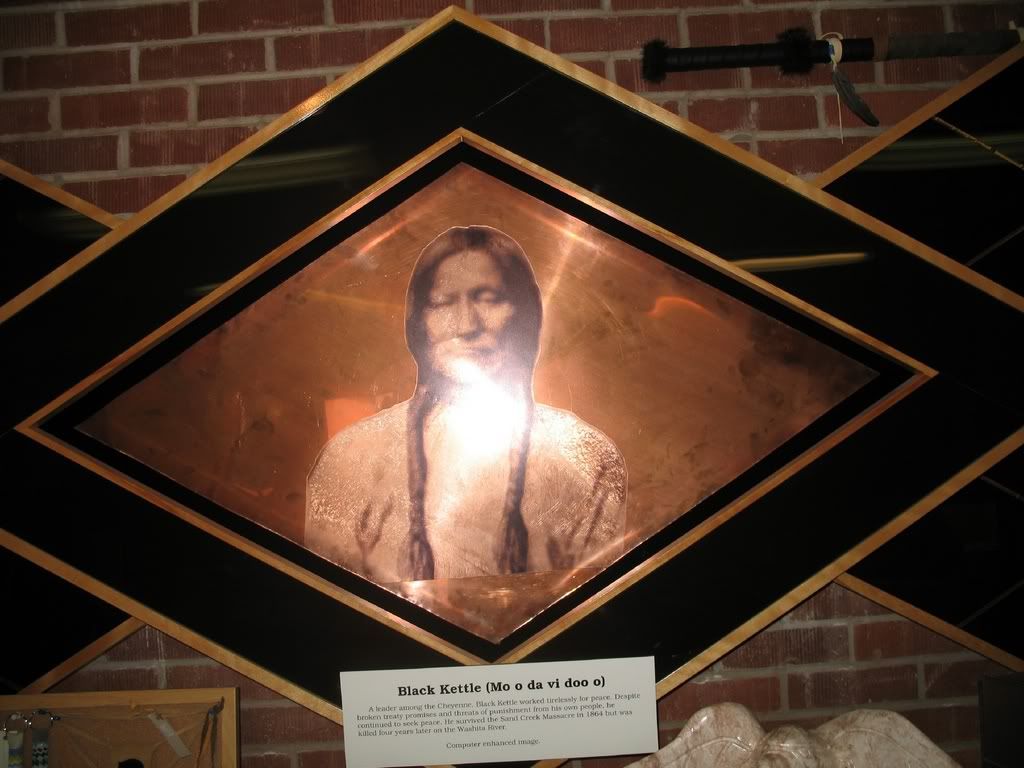Custer was pursuing the snow tracks of Dog Soldiers that would eventually lead to Black Kettle’s village on Thanksgiving Day in a cruel irony. The cruelest irony however, was that Black Kettle and his wife would be slain nearly four years to the day that they both escaped Chivington at the Sand Creek Massacre. Black Kettle’s honesty concerning young men in his village he could not control was of no avail. He and his village were going to be "punished" and broken beyond any immediate or distant recovery.

(Taken with permission)
Crossposted at Progressive Historians
John Corbin, the messenger from Major Elliot, rode up and informed Custer of two large Indian snow tracks. One was recent. Preparations were then made to pursue the "savages" as covertly as possible. Smoking ceased and weapons were bound to prevent visual or aural detection. In addition, the 7th whispered and paused frequently as they rode slowly towards the future tracks that would lead to Black Kettle’s village. Simultaneously, Black Kettle received dire warnings that he and the others ignored. A Kiowa war party gave the first warning of having seen soldier’s tracks that were heading their direction. It was discounted. Black Kettle’s wife, Medicine Woman, gave another warning that night before the 7th’s arrival of an intuitive nature during the meeting in the Peace Chief’s lodge by firelight. She begged them to move immediately. It too was dismissed. They would move the next day, instead.
Black Kettle had already moved their camp recently, which the returning war party that had helped in the Kansas Raids learned upon their returning. November 25th found this war party dividing into two different directions in order to reach their destinations the quickest. Approximately 139 of them traveled to the big village on the river, while about 11 of them led Custer straight to Black Kettle. A bell around one dog’s neck enabled all the dogs to be located easily by the tribe, and after a Cheyenne baby cried, Custer pinpointed their exact location. He coordinated the attack to begin at dawn from four fronts.
Thompson’s troops would attack to the North East, Myer’s and Custer’s troops positioned to attack to the East and South East, while Elliot would attack to the South. Custer knew their mobility was greatly hampered in winter time; consequently, that was an important element in the "campaign."
The village slept as the first morning rays were darkened by grey clouds, then a 7th Calvary rifle broke the silence, echoing through the trees. Custer’s military band played "Gary Owen," but the song sounded flat before the instruments froze, halting the song in the chilling air. A woman dashed into the village to warn Black Kettle of the coming troopers; he hastily snatched his rifle from his lodge and fired a warning shot for all to awaken and flee. If he had attempted to meet the soldiers and ask for peaceful negotiations, that would have been useless; as a result, he then mounted his horse with his wife, Woman Here After, and tried to escape through the North direction. His horse was shot in the leg before bullets knocked him and his wife off the horse and into the Washita River, where they both died together.
A few miles from Black Kettle’s death

Conclusion
I hope against hope that this story of reconciliation and forgiveness recited below serves as a beacon of light in the darkness which seems to be encroaching as the war escalates and genocide is being ignored. Indeed, since the descendents from Sand Creek and the 7th Calvary were able to reconcile, may that serve as an example that it is possible after a century for descendents to forgive, though they cannot forget.
Moxtaveto ("Black Kettle") at Washita: 11- 27, 1868 (Re-introduction)
I had gotten into a discussion with a woman in Cheyenne about Washita, and she told me how a couple men coordinated the event of reconciliation. It involved a reenactment with Sand Creek Massacre descendants and grandsons of Custer’s 7th Calvary at the same location Black Kettle was murdered by Custer. Paramount was the re-burial of a child victim’s bones.
The descendants camped where Custer’s 7th Calvary had attacked Black Kettle’s camp one century earlier; however, they were unaware that the grandsons of Custer’s 7th would be coming over the hill firing guns with blanks in them. When the 7th Calvary’s grandsons came towards them on horses firing blanks in their weapons, there were many feelings of surprise, fear, anger, and betrayal experienced by the Sand Creek Massacre descendants. Remember, the Sand Creek Massacre descendants and the ones who were slain at Washita were the same individuals.
Source
Unknown to the Cheyenne,a California
group called the Grandsons of the
Seventh Calvary,Grand Army of the
Republic,had been asked to join the
Reenactment-
A line was formed after the reenactment with the grandsons of the 7th Calvary, who obviously wanted to help in this healing, at the front of the line. Lawrence Hart, a Mennonite pastor, felt very angry as he watched the bones of the child being passed down it towards the front. A Native woman then put a blanket over the little coffin containing the child’s bones, which continued to be passed down the line to Hart. The blanket was then handed to him.
Among the Cheyenne was Lawrence Hart, a peace chief and a Mennonite pastor. The celebration became tense. The final event of the day was the re-burial of the victim’s remains. The small coffin was covered with a beautiful new woolen blanket. According to Cheyenne tradition, the blanket would be given to a guest.
The older peace chiefs asked Hart to give the blanket to the captain of the Grandsons of the Seventh Calvary! He couldn’t believe what they were asking. This man was the enemy! Hart’s own great-grandfather, Afraid of Beavers, had barely escaped the attack by hiding in a snowdrift.
Hart was tense. As the captain came forward, Hart told him to turn around. Hart’s trembling hands then draped the beautiful blanket over the captain’s shoulders.
It was a grand moment. The wise Cheyenne peace chiefs had initiated peace. The Grandsons embraced the chiefs. Some cried. Some apologized. When Hart greeted the captain, the officer took the Garry Owen pin from his own uniform and handed it to Hart.
"Accept this on behalf of all Cheyenne
Indian people," the captain said. "Never again will your
people hear Garry Owen."
Read that last sentence again said by the captain, and remember that "Gary Owen" was the song Custer had his band play right before the murdering began at Washita.
"Accept this on behalf of all Cheyenne
Indian people," the captain said. "Never again will your
people hear Garry Owen."
The lady I spoke with said there wasn’t a dry eye left.
Next, the conclusion of this and the following: Moxtaveto ("Black Kettle") at Washita: November 27, 1868 (Introduction) (Updated Title),
Moxtaveto ("Black Kettle") at Washita: 11- 27, 1868 (Re-introduction),
Custer In The Whitehouse & The Abandonment Of Major Elliot (Updated),
Custer "Stayed The Course" & The Kansas Raids,
Custer's Indian Hostages: (One White Woman & 2 White Children, Part 1),
and Custer's Indian Hostages: (One White Woman & 2 White Children, Part 2),


